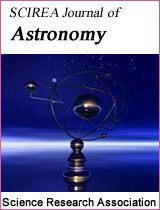ON THE ORIGIN OF MOON AND CONTINENTS
DOI: 10.54647/astronomy16035 100 Downloads 97661 Views
Author(s)
Abstract
All astronomical bodies originate inside clouds of gas and dust, therefore there should be a common process that leads to their condensation. A galactic cloud normally has some turbulence and therefore a gradient of speeds from point to point. Thanks to it, a vortex originates that rakes the material of the surrounding cloud gradually forming a large gaseous disk, inside which vortices of second order develop which concentrate the matter of their orbits forming smaller and much denser disks, within which third order vortices further concentrate the matter. The dense cores of these vortices finally condense in massive bodies: sun, planets and satellites. The result should be a well ordered planetary system with no “debris” around and where both planets and satellites obey to a precise rule of the distances from their central body.
The solar system complies with these conditions with three main exceptions. First, in an orbit where a large planet should be there is only a huge number of scattered asteroids. Second, Earth and its moon with all evidence were not formed in the same vortex, which means that Moon originated somewhere else. Third, Neptune’s satellite system has been shattered by the intrusion of a foreign body, Triton, and its largest satellites are missing.
These exceptions seem to be strictly connected to each other and all due to a unique event, that is: Triton has diverted the largest Neptune satellite towards the Sun. The satellite impacted at high speed against the missing planet, scattering myriads of fragments from its mantle and pushing it towards the sun, where it eventually fell. The planet had at least 4 or 5 satellites some of which remained in their previous orbit, but two of them were dragged towards the sun and were captured by Earth. The largest became its lonely moon while the second fell on its surface giving origin to the continents. Prevailing
This event happened about 3,96 billion of years ago, as it is proven by the ages of the numerous samples brought from the moon, which composition supports the proposed scenario.
Keywords
asteroids, vortex, multiple stars, planets, satellites
Cite this paper
Flavio Barbiero,
ON THE ORIGIN OF MOON AND CONTINENTS
, SCIREA Journal of Astronomy.
Volume 4, Issue 1, February 2022 | PP. 1-19.
10.54647/astronomy16035

